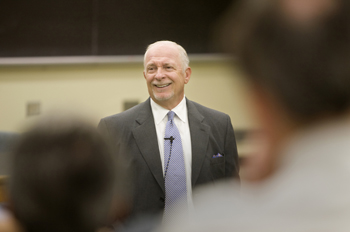
Harry Jacobson, M.D., speaks at last week’s Fall Faculty Meeting. (photo by Joel Howell)
Medical Center’s financial position sound: Jacobson
Vanderbilt Medical Center's financial performance is sustainable given current economic conditions because “we deliver high quality care at a reasonable price,” Harry Jacobson, M.D., vice chancellor for Health Affairs, told audience members last Thursday at the Fall Faculty Meeting in 208 Light Hall.
VMC has the second lowest cost per discharge in Middle Tennessee, Jacobson said, and an average cost per discharge that compares very well nationally. For example, institutions such as the University of Pittsburgh Medical Center have costs nearly twice that of Vanderbilt.
Jacobson also spoke optimistically when asked by faculty members what impact the nation's current economic crisis would have on philanthropy, the National Institutes of Health budget and the Medical Center's ability to borrow.
He predicted that the market will turn around by year's end and said, “challenges are being met appropriately” at the federal level.
Jacobson outlined the Medical Center's progress in 2008 and highlighted focused, balanced goals for 2009 by discussing the five elevate pillars — people, service, quality, growth and finance.
Under the service pillar, Quality of Care survey results from July 2007-June 2008 are above the 90th percentile goal in every area except for clinic visits, which has improved to the 81.9 percentile with 71.7 percent “Excellent” responses.
The Emergency Department of the Monroe Carell Jr. Children's Hospital at Vanderbilt scored the highest, with 97.9 national percentile, followed by Outpatient Technical (95.8) and the Adult Emergency Department (94.8). Adult and Children's Inpatient ratings both bested the 90th percentile, as did Outpatient Surgery.
Faculty members were briefed on topics across campus including new leadership at the Vanderbilt-Ingram Cancer Center and the quality of School of Medicine and School of Nursing applicants and faculty.
Beth Price will hold the newly created CEO position for Vanderbilt-Ingram Cancer Center, which follows a trend of adding expanded, first-class management teams for important clinical programs at Vanderbilt.
Jacobson said this is important in areas that have become such large enterprises and it is working well at the Vanderbilt Heart & Vascular Institute.
The number of underrepresented minorities in the School of Medicine's Class of 2012 is roughly 20 percent and the School of Nursing's Doctor of Nursing Practice (DNP) program was “wildly successful” in its first year, Jacobson said.
The Medical Center is continuing its expansion to 100 Oaks with construction on schedule for substantial completion by January 2009; the expansion of the Children's Hospital is moving forward; a $169 million Critical Care Tower on campus is under construction; and the Vanderbilt-Ingram Cancer Center has a clinical expansion project under way.
Vanderbilt Medical School research ranked 10th in NIH funding for 2007, with $282.2 million, now up 14 spots from the national rankings in 2000.













